|
Getting your Trinity Audio player ready...
|
ARTICLE. From Coastside Chronicles, a publication of the Half Moon Bay History Association, Spring 2023.
Many people know of author Ken Kesey, famous for writing One Flew Over the Cuckoo’s Nest, but fewer know that he spent a significant period in his life in La Honda. His house and property, nestled in the redwoods on La Honda Road, have a storied history that started with his infamous parties in the 1960s.
The story continues to the current day with the owners who bought the property in 1997 and faithfully restored it after it had seen years of neglect and a near-catastrophic flood in 1998.
La Honda today is so bucolic and serene, it is hard to imagine that back in the 1960s it was home to mind-bending LSD-laced parties attended by writers including Allen Ginsberg, Tom Wolfe, and Hunter S. Thompson, as well as the Grateful Dead, and a group of Kesey associates who called themselves the Merry Pranksters.
The story of Kesey’s house began when, at the invitation of Vic Lovell, a Stanford psychology graduate student, Kesey volunteered to take part in a CIA-sponsored secret military program at the Menlo Park Veterans’ Hospital where he worked as a night aide. The project studied the effects of psychedelic drugs, including LSD, on the test subjects.
Kesey said that his role as a drug guinea pig, as well as his experiences working at the hospital, inspired One Flew Over the Cuckoo’s Nest.
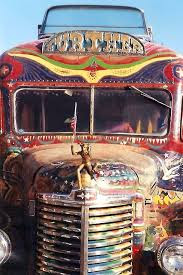
The book’s success allowed him to buy the La Honda property in the late 1950s, and he lived there until the early 1970s with wife Faye and their two children.
Kesey held frequent parties and “Acid Tests,” where fluorescent paint, black lights, strobe lights, and large amplifiers provided psychedelic effects for attendees. These parties were described in some of Allen Ginsberg’s poems as well as Tom Wolfe’s book The Electric Kool-Aid Acid Test. Writer Hunter S. Thompson wrote an account of one event in his book Hell’s Angels following a particularly mind-bending party to which he invited 40 of the bikers to Kesey’s property where they took LSD.
Wolfe also immortalized a Kesey road trip in a psychedelically painted 1939 Harvester school bus named Furthur. The bus was driven by Kesey’s associate Neal Cassady, the inspiration for Dean Moriarty in Jack Kerouac’s On the Road.
Further carried the Merry Pranksters, orange juice laced with LSD, and Wolfe, who documented the trip. He said the trip had a dual purpose, “One was to turn America on to this particular form of enlightenment,” the other was to publicize [Kesey’s] new book, Sometimes A Great Notion, written at his La Honda home.Aside from his fame as an author, Kesey is remembered as a psychedelic counterculture figure who helped usher in the hippie movement and served as a major inspiration to the counterculture movement. He viewed himself as the link between the beat movement and the hippies.
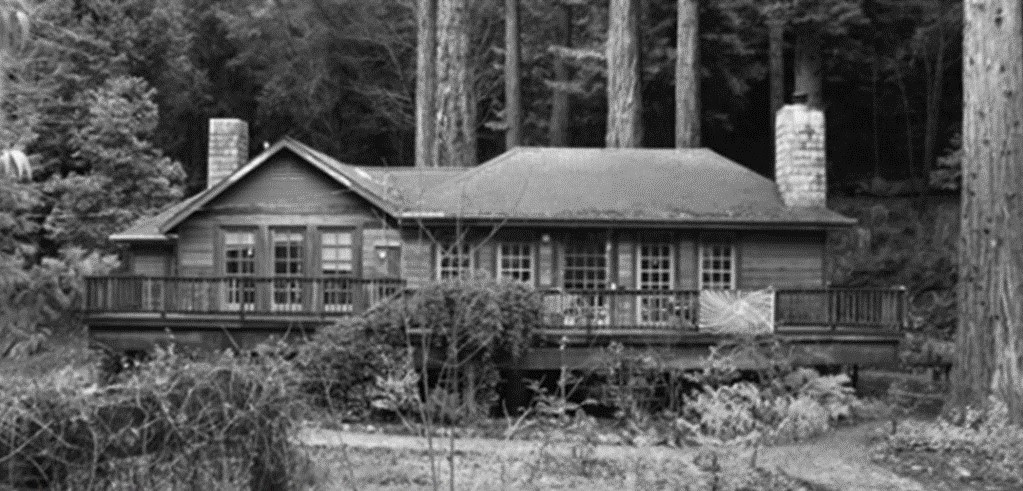
In 1965, Kesey and 13 friends were arrested for growing marijuana on his property, and he was imprisoned for five months. Shortly thereafter he settled in Pleasant Hill, Oregon, where he maintained a secluded, family-oriented lifestyle for the rest of his life. The La Honda home was variously rented or vacant for over 30 years until it was sold in 1997.
At the time of the sale of the house, San Francisco Chronicle reporter Michael McCabe caught up with Kesey, making the mistake of calling the house a cabin. “First of all, it is not a nice little cabin,” Kesey growled. “It is a big nice old house in the middle of a redwood forest.”
Then he turned the telephone over to his wife Faye, who said that they were “selling the cabin partly to get some money after settling out of court with a San Mateo County sheriff’s deputy who sued them.” The La Honda cabin sold for $239,000 Kesey said “because it had become rundown, and vandals had looted several relics of the Merry Prankster era, along with pieces of artwork, collages, and other mementos.”
Current owner Terry Adams has many talents, including authoring many poems including a collection called Adam’s Ribs. He says on his website that “in 1997 Kesey’s La Honda house was a Fixer-Upper, accessed only by forest trail or foot bridge across the San Gregorio creek.” No banks were willing to provide financing, so the new owners financed directly with Kesey.
Bringing this story full circle, Kesey’s dedication to One Flew Over The Cuckoo’s Nest read “To Vic, who told me there were no dragons, then led me to their lairs.”
Adams says “that same Vic Lovell is an old friend of mine and helped negotiate the sale, explaining to Ken that I was not only a poet, but a Masters in literature, a psychedelia aficionado, a General Contractor, and motorcycle racer to boot! A perfect fit!” You’ll remember that Lovell also recruited Kesey to the CIA study that started this epic.
Adams believes the original structure from the 1940s may have been a hunting cabin, noting that the house is much larger than it appears from the street. On the sale’s closing day Ken referred to the house as his “Viking Lodge.”
Adams and wife Eva Knodt’s early years at the house were anything but easy, as he notes “the El Niño flood of February 2nd, 1998, almost destroyed the house, but flood insurance and a FEMA Disaster loan allowed us to restore it.” He goes on to say that “both Eva & I are woodworkers and builders, and we preserved the antique aesthetic of the house, removing, numbering, and restoring original interior paneling.”
Terry continues the story, stating “After we moved back in, in 1999 Ken and the Pranksters, including Ken Babbs, Mountain Girl, George Walker, and Roy Sebern, and newer faces, visited us in Furthur, on their way to England to look for Merlin. After a tearful tour of the re-built house – several pranksters were touched to see the old place given new life.” Ken Elton Kesey passed away on November 12, 2001, age 86.
Adams says that “on the 50th anniversary of the 1964 Furthur tour, Ken’s son Zane and a gaggle of new Pranksters re-traced the original cross-country route, finishing at our place in 2014,” A fitting end to this story.
Adam’s website notes that “We show the house occasionally to school classes, researchers, and interested folks from all around the world, but it requires a balance since we have no ambition to be a public site.
Bit of Kesey whimsey:
In 1994 author June Morrall was preparing an article for the San Mateo County Historical Association’s journal La Peninsula.
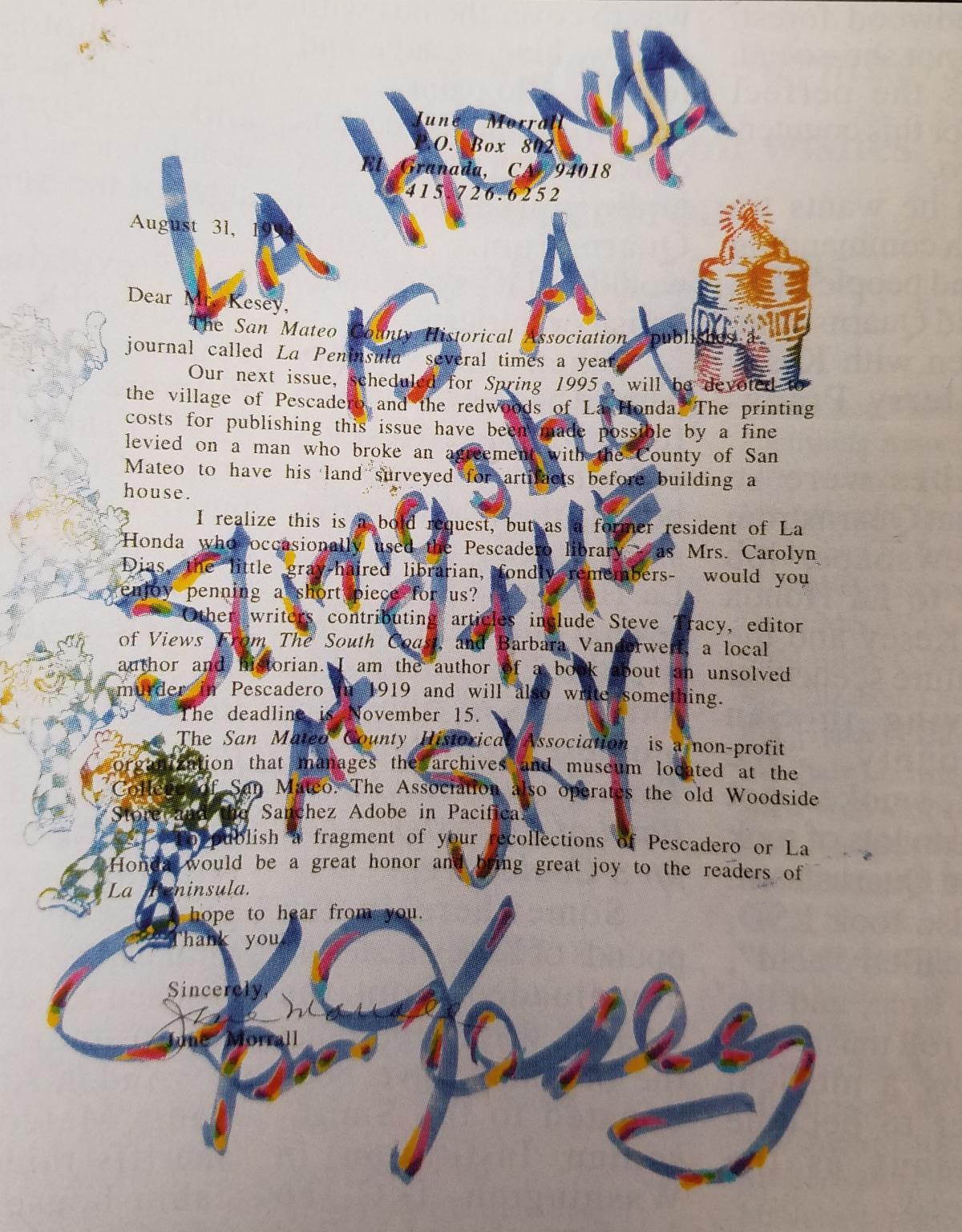
She wrote to Kesey: “Our next issue…will be devoted to the village of Pescadero and the redwoods of La Honda…I realize this is a bold request, but…would you consider penning a short piece for us?”
Kesey replied by penning this short piece
on Ms. Morrall’s original letter


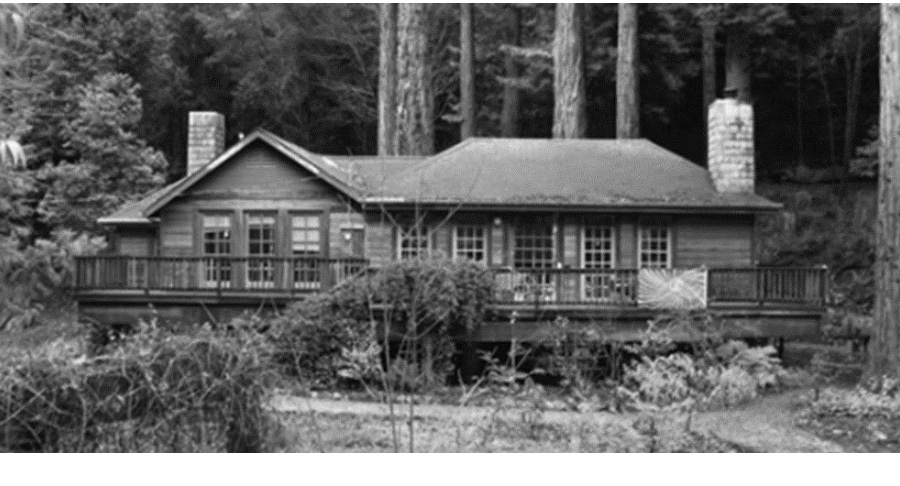
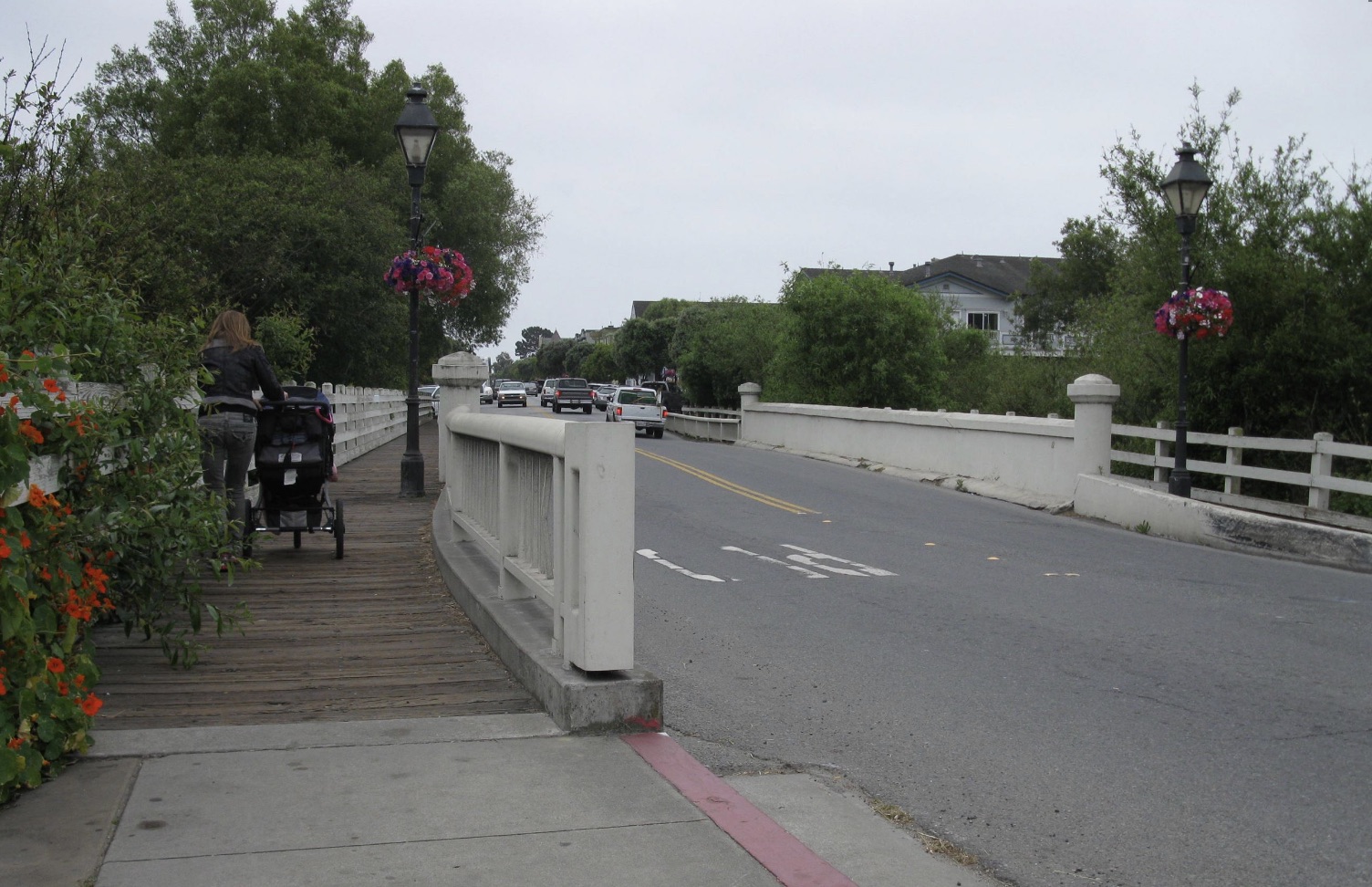
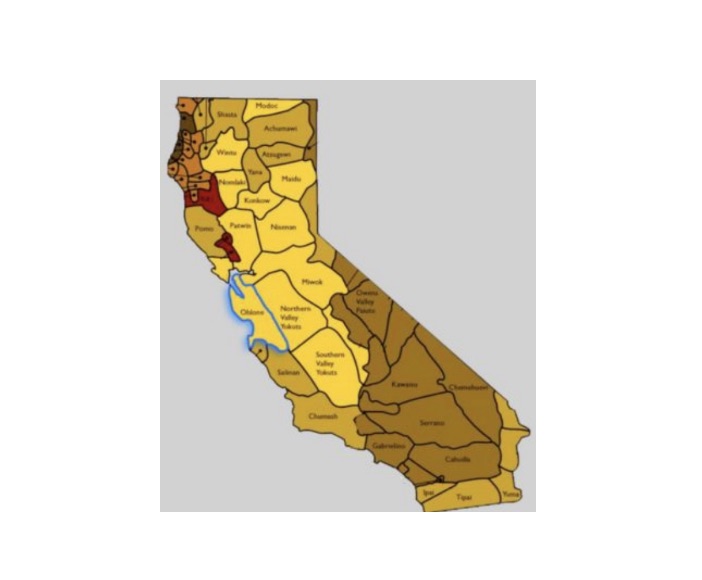
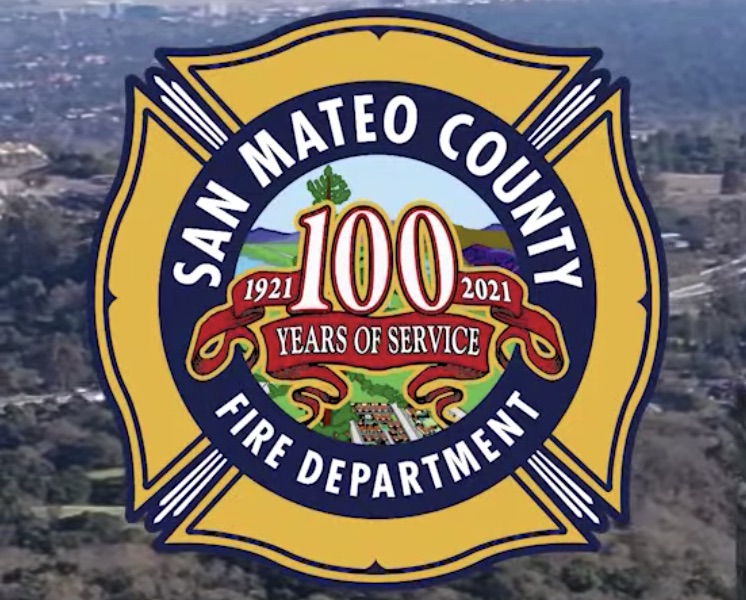
Stegner’s writing program at Stanford attracted a slew of what were to become major western authors, in addition to Stegner, himself, to our area–Kesey, who attended on a Woodrow Wilson National Fellowship, of course, and many of my favorites like Ed Abbey (who dropped out of the program), Raymond Carver, and William Kittredge. Kesey won me over with *Sometimes a Great Notion* as he got the details of logging activities, small lumber town character, and the personalities of the people involved in extracting and refining cellulose towers from the environment spot on. I still think of him every time I buy a tub of Nancy’s yogurt.